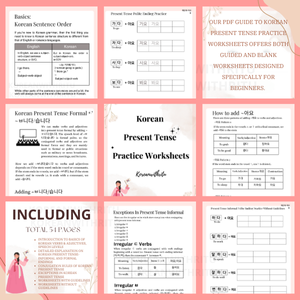Korean present tense describes actions that are happening right now or habits that are repeated regularly. Verbs are conjugated based on the speech level (formal, informal, etc.) and the verb stem.
Table of Contents
Here’s a simple explanation of how to form the present tense:
- Find the verb stem:
- Remove the “다” (da) from the dictionary form of the verb.
- Example: 먹다 (meok-da, “to eat”) → 먹 (meok) is the verb stem.
- Add the appropriate ending based on formality:
Informal polite (commonly used):
Add “아요” (ayo) if the last vowel of the verb stem is “ㅏ” (a) or “ㅗ” (o), and add “어요” (eoyo) for other vowels and for verb stem ending with “하다” “여요”
- Example: 가다 (ga-da, “to go”) → 가요 (gayo, “I go”)
- Example: 먹다 (meok-da) → 먹어요 (meokeoyo, “I eat”)
Add “여요” to the verb stem ending with “하다”
- Example: 하다(ha-da, “to do”) → 해요(haeyo, “I do”)
Formal polite:
Add “습니다” (seumnida) for consonant endings or “ㅂ니다” (mnida) for vowel endings.
- Example: 먹다 → 먹습니다 (meokseumnida, “I eat”)
- Example: 가다 → 갑니다 (gamnida, “I go”)
You might like: Get our Korean Present Tense Workbook to master this grammar on a special discount right now.
Korean Present Tense Practice Worksheets For Beginners | Digital Download | Printable PDF
Our Korean Present Tense Practice Worksheets offers both guided and worksheets without guidelines designed specifically for beginners. This resource provides […]
However, there are some exceptions in Korean present tense conjugations.
Exceptions In Korean present Tense:
Here’s a table with some common exceptions in the Korean present tense
1. ㄷ Irregular Verbs (Example: 듣다 → 들어요)
In verbs like 듣다 (deud-da, “to listen”) and 걷다 (geod-da, “to walk”), the stem ends with “ㄷ”. When followed by a vowel, the “ㄷ” changes to “ㄹ”.
| Verb | 듣다 (to listen) | 걷다 (to walk) |
| Base | 듣 (deud) | 걷 (geod) |
| Present Tense | 들어요 (deureoyo) | 걸어요 (georeoyo) |
2. ㅂ Irregular Verbs (Example: 돕다 → 도와요)
In verbs like 돕다 (dob-da, “to help”) and 춥다 (chub-da, “to be cold”), the “ㅂ” changes to “우” or “오” when conjugated before a vowel.
| Verb | 돕다 (to help) | 춥다 (to be cold) |
| Base | 돕 (dob) | 춥 (chub) |
| Present Tense | 도와요 (dowayo) | 추워요 (chuwoyo) |
Practice this grammar point with our Flashcard Quiz for Korean Present Tense now.
3. 르 Irregular Verbs (Example: 모르다 → 몰라요)
For verbs like 모르다 (moreu-da, “to not know”) and 이르다 (ireu-da, “to arrive”), the “르” changes by adding an extra “ㄹ” when followed by a vowel. The final form often shortens the vowel.
| Verb | 모르다 (to not know) | 이르다 (to arrive) |
| Base | 모르 (moreu) | 이르 (ireu) |
| Present Tense | 몰라요 (mollayo) | 일러요 (illeoyo) |
4. ㅅ Irregular Verbs (Example: 짓다 → 지어요)
In verbs like 짓다 (jit-da, “to build”) and 낫다 (nat-da, “to heal”), the “ㅅ” disappears when followed by a vowel.
| Verb | 짓다 (to build) | 낫다 (to heal) |
| Base | 짓 (jit) | 낫 (nat) |
| Present Tense | 지어요 (jieoyo) | 나아요 (naayo) |
These are some common irregularities you’ll encounter in Korean present tense. Each pattern has its exceptions and specific verbs that follow the rule.
Related: Download our Free Korean Present Tense Informal Polite Guide from here.




